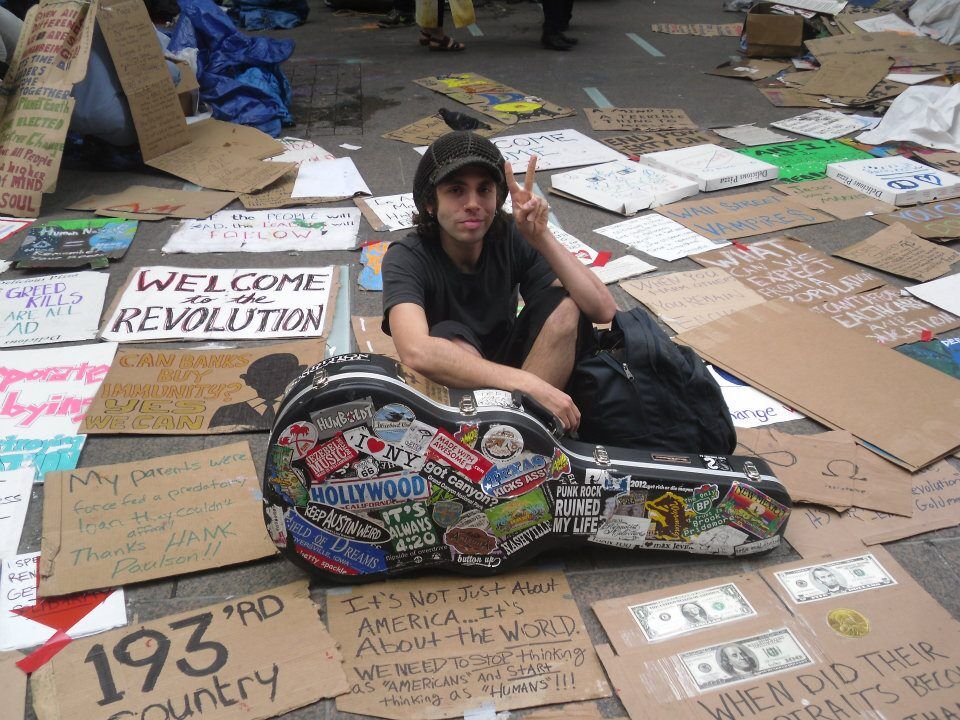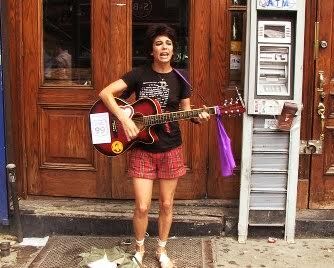
Back in the 1950s and 60s, New York’s Greenwich Village played a role in establishing the counterculture with its vibrant scene of anti-establishment beat poetry and folk music. That renegade spirit is still very much alive among a new generation of New York base protest singers and poets.
This is the premise of a new documentary by acclaimed documentarian Karen Kramer. She draws parallels with the golden age of artistic activism and what is currently taking place in New York. She does this by telling the stories of three poets and three folk-singers who ply their art.
One of the main themes that Kramer weaves throughout the film is non-conformity. She effectively uses 1950s stock footage and Malvina Reynolds “Little Boxes” to highlight what the beat poets and folk-singers were rebelling against. She juxtaposes those images with modern day examples of consumerism. It also features a brief snippet of modern day folk singer-songwriter Matt Pless performing an updated version of “Little Boxes”, which help tie the two time periods together.
The anti-conformist ideas that Reynolds conveyed in “Little Boxes” are continually explored throughout the film. The six main subjects featured in the film expressed that their desire not to be boxed in is what shapes both their art and activism. In many cases, it was that desire to fight the status quo that led them to New York.

Singer and activist Tiffani Hillin fled Amarillo, Texas “the buckle of the Bible belt” to escape religious oppression and narrow mindedness.
Before finding his way to New York, Baltimore native Matt Pless started touring across the country performing his socially conscious folk tunes wherever he could. To Pless, a life of couch surfing and no fixed address was better than the alternative of being placed in the dreaded box of conformity (Matt Pless’ “When The Frayed Wind Blows” was previously featured as a Daily Dose of Protest).
One of the few that didn’t move to New York, was Bronx born spoken word artist Saroya Marsh (referred to as Roya in the film). Her art and activism were influenced by the injustices that she seen and experienced as a black woman. To Roya, poetry is a powerful way to speak out against injustice and inspire change. One of the poignant lines she cites “You are David, nothing is too Goliath for your soul to conquer” highlights her optimism in overcoming systemic oppression.
Along with the modern day subjects, Kramer prominently features Greenwich Village alumni such as beat poets Hettie Jones and Wavy Gravy, folk-singers Peter Yarrow (Peter, Paul and Mary) and Maria Muldaur. It also features plenty of archival footage of Allen Ginsberg, Bob Dylan, Woody Guthrie, Pete Seeger, among others.

Another way that Kramer effectively uses archival footage is by showing the similarities between protest movements. As a viewer, you can see the links between the civil rights movement and Black Lives Matter, past union rallies with Occupy Wall Street, or peace rallies with the Vietnam War with those in connection with the war in Afghanistan. It was also a heartening moment seeing footage of Joan Baez perform at both 60s protest rallies and more recently at an Occupy Wall Street rally. The one constant with protest movements is the important role that music and poetry continue to play.

Another parallel is how political art has always made the status quo uncomfortable. Efforts to suppress free expression continue to exist. It discusses past efforts to blacklist and label artists as commies. It also juxtaposes efforts to ban folk-singer performing in the park with a modern-day subway busker being arrested.
As mention in the film’s press release “Renegade Dreamers is a window into the New York protest poets and folk singers of today who use their art for social change, interwoven with a look back at the Beat poets and radical protest singers of the legendary Greenwich Village coffee house scene of the ‘60s that started it all.” It is a window that is well worth looking through.
Renegade Dreamers will be receiving it theatrical release between May 31-June 6 at Cinema Village in New York City. Hopefully, in the future, it receives a wider distribution, because it deserves to be watched by as many as possible.